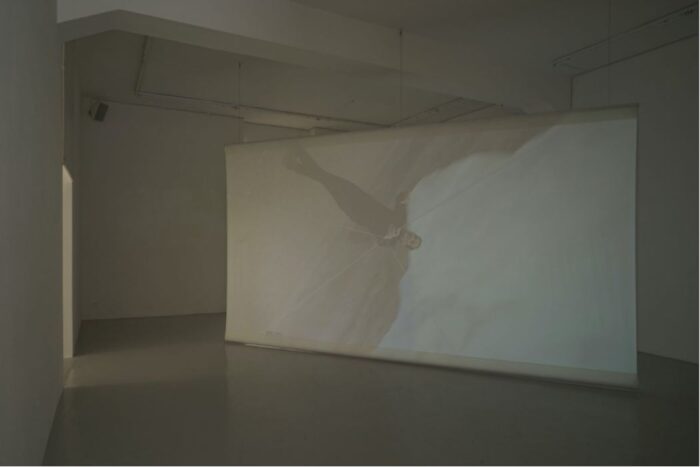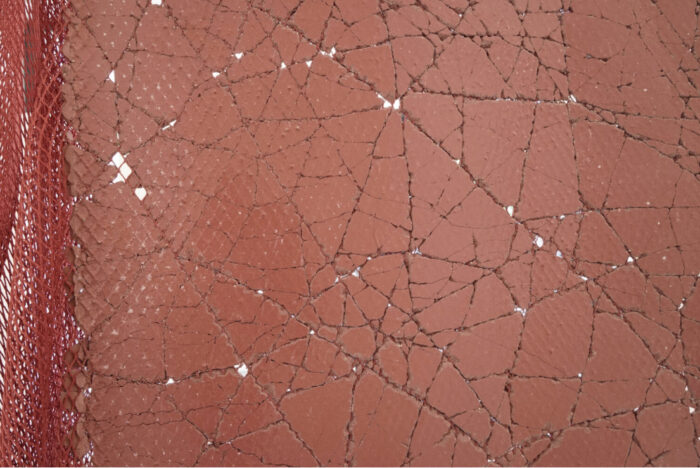




Katja Schenker at Lullin + Ferrari, Zürich
28 May – 24 Jul 2021
All Images courtesy of Lullin + Ferrari
Apart from drawings, the exhibition includes all artistic forms of expression that Katja Schenker uses. The starting point of her work is always her own body. This is revealed in different forms in the works shown in the exhibition.
The sculpture, as its dimensions and weight already point out, was created directly on site in the gallery. The reddish-brown volume occupies the centre of the room through the artist’s precise placement. The iron oxide colour of the concrete and the reddish nylon net evoke associations with organic material. This impression is reinforced by the brittleness of the material, the crack lines and recesses. The production of the sculpture, which required great physical effort, is of some importance for the reception of the work: the way it was made can only be comprehended to a limited extent in the finished work of art, and perhaps it must not be told in all its details in order to preserve the magic. But it should be said that the balance of the composition owes much to the principles of chance and precise decisions. The fracture lines of the concrete refer to Katja Schenker’s drawings. She has worked the skin-like surface in different ways with her whole body and with tools. The timing of the intervention is important: a few hours after the concrete has dried, the resulting concrete surface is less brittle than if it had already been drying for over 24 hours. These technical considerations have been taken into account in the treatment of the red surface. For Katja Schenker, it is important that the cracks spread out in such a way that it remains in the balance whether the structure holds together or threatens to break apart.
Next to the performative sculpture hangs a monotype that reproduces imprints of parts of Katja Schenker’s body in printed concentration. Traces of the right upper part of her body and her hip are recognisable. As in the performative sculpture, movement sequences and imprints are also hold in condensed form in this monotype.
In the main room, Katja Schenker presents the video Satka for the first time in Switzerland. The video shows a performance recorded in 2019 in a magnesite mine near the town of Satka in the Ural Mountains produced for the 5th Ural-Biennial with support from Pro Helvetia Moscow. The site of the action is a landscape shaped by dredging machines, which is subject to a constant process of transformation by humans. The volatility, the instability of this desolate, barren stretch of land corresponds to the mood and perspective that the artist conveys in her video performance Satka. Filmed with a GoPro camera with technical support from Severin Kuhn, the image never stands still. The horizon fluctuates. Katja Schenker whirls around and seems to defy gravity. The only fixed point is the knot in the white string on which the artist swings the camera around her body. In this way, Katja Schenker opens up a space with Satka, asks us where we are standing and where we come from. At the same time, this video performance is an analysis of the body and its physical possibilities. How long will Katja Schenker be able to turn in circles like this?
The video performance Satka is also about the view of the body of the artist herself, filmed from thousands of angles by a swinging GoPro camera. The buzzing, dragging sound of the rotating camera reinforces the impression of the immutability of human existence.
In the rear garage space stands the massive yet poetic sculpture from the series How Deep is Time? Cut. The group of works was created in connection with Katja Schenker’s impressive art-in-building project in the atrium of the University of Applied Sciences and Arts Northwestern Switzerland in Muttenz; a building by pool Architekten from Zurich.
In all her works, Katja Schenker raises fundamental questions about human existence. In her performative sculpture, the artist struggles with the material and for expressive power, her body being the pivot of her artistic work.
Katja Schenker, born 1968 in St. Gallen, lives and works in Zurich. After studying comparative literature, art history and philosophy at the University of Zurich and at the Ecoles des Hautes Etudes in Paris, she interned at the Zurich School of Art and Design. She has come to the fore with numerous performances, art-in-architecture projects and exhibitions at home and abroad. On 10 June 2021, Katja Schenker will be awarded a recognition prize by the St. Gallen Cultural Foundation.
